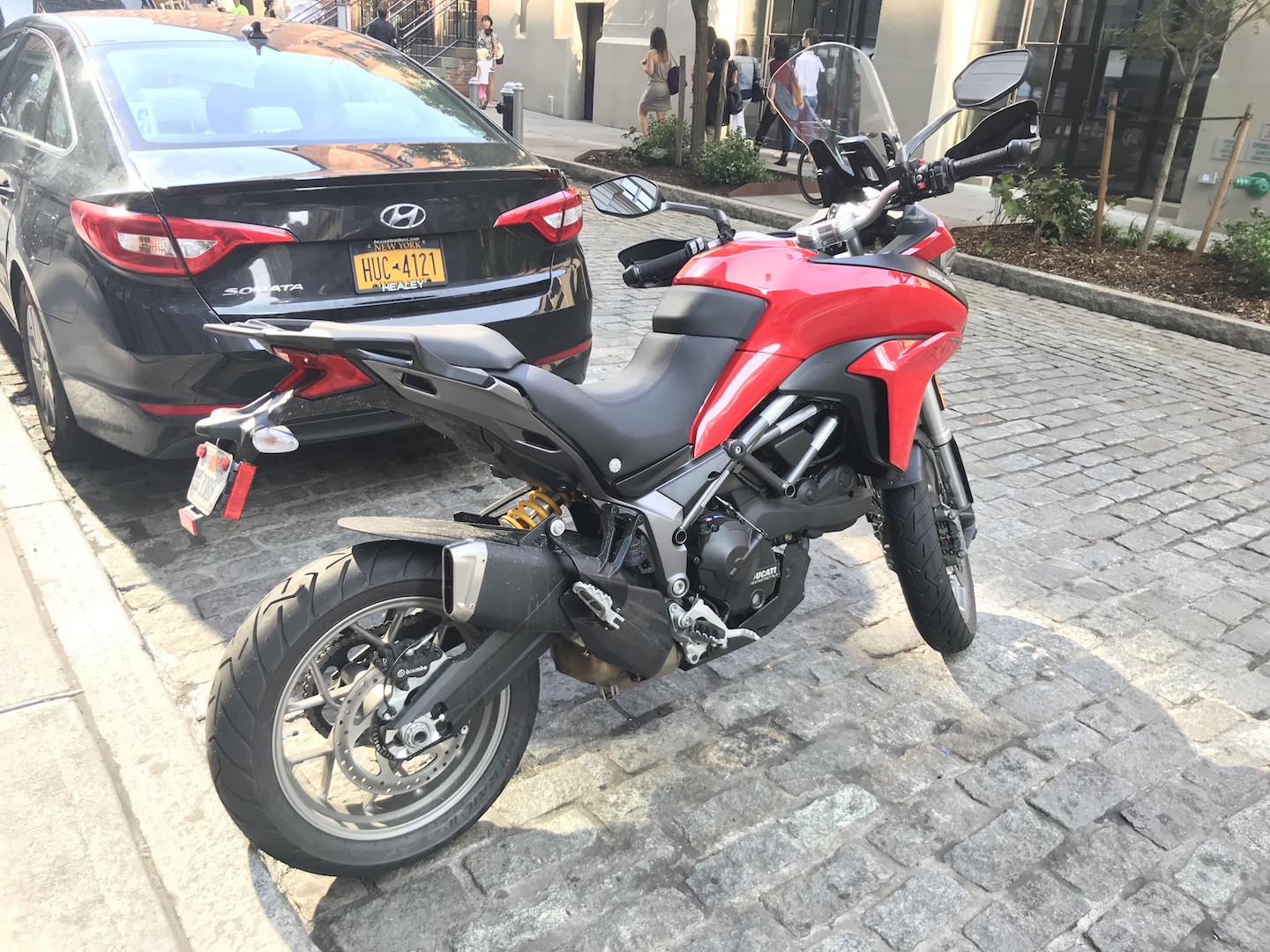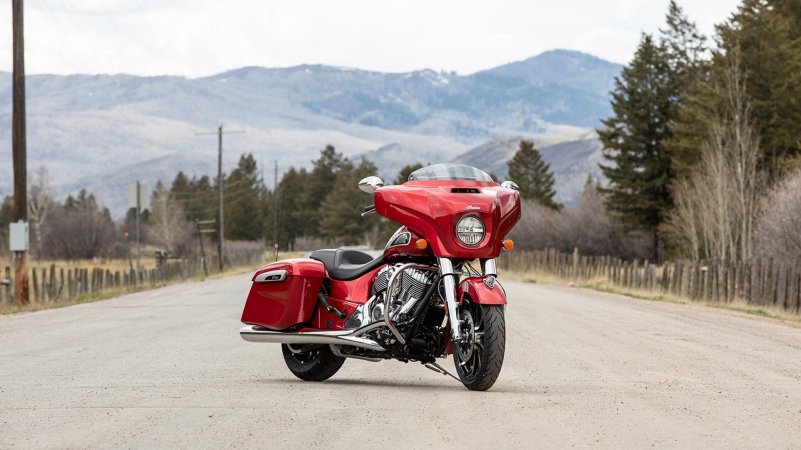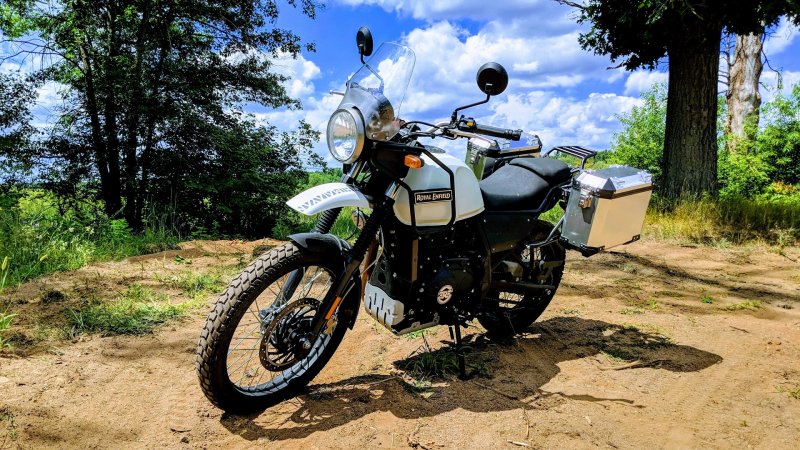

We may earn revenue from the products available on this page and participate in affiliate programs. Learn more ›
Because I’m extremely lazy in a way that requires a lot of work, it takes me a long time to buy anything. I don’t like having a lot of stuff, so I find something that I like, whether it’s a pair of jeans or a chef’s knife, use the hell out of it, and replace it with the same exact thing once it’s well and truly worn out. Because I’m also very particular and review things for a living, this can take months.
Or, in the case of a motorcycle, years. I first thought of getting a bike back when I lived in Los Angeles, but didn’t pull the trigger until much later, after I had moved back across the country to New York City. It’s a daunting task, picking a new bike, even if it’s just new-to-you. It’s a significant purchase, and there are countless options—endless combinations of displacement, style, functionality, speed, price, and looks—especially if you’re also scrolling the used market.
Luckily, in my line of work, I was able to test out a bunch of different styles—dual-purpose bikes, adventure-tourers, cruisers, motards, scramblers, and retro UJMs—before I finally decided not just which bikes I liked most, but which format suited me best. I wanted to find a bike that I would use a lot, that wasn’t too expensive or precious, that was able to get me out of the city on longer rides, and that I could hold onto for years and modify how I want.
My ultimate choice succeeds on several fronts and fails spectacularly at the rest. Life is full of compromises. I still spend a lot of time reading about motorcycles and second-guessing my decision while off the bike, but have never doubted my choice for a second while riding. What I finally settled on after all those years is not the perfect bike, but don’t tell that to me.
Cruiser: Indian Scout Bobber
Price: $11,999
Characteristics: Slammed stance, lots of power and style, relaxed riding position
Engine: 1133cc V-Twin, 100 hp, 72 lb-ft
Good for: Cruising
Not suited to: Bad roads, tight spaces

Indian loaned me this bike in LA when I was out there for the auto show, and it was the perfect choice for the city’s wide, well-paved, motorcycle-friendly streets. It’s low-slung and loud, with excellent build quality: It feels like it was carved out of one solid piece of heavy metal, made to go very fast with a 69-cubic-inch, 100-horsepower V-Twin engine, then fitted with things like ABS, a six-speed transmission, and street tracker handlebars. The slammed stance with minimal suspension travel would make for a rough ride through the apocalyptic hellscape that is New York City’s commuter infrastructure—though I see plenty of these bikes, and similar competitor models from Triumph and Moto Guzzi, all around town—but it was a phenomenally fun LA bike, exceptionally smooth and fast, comfortable to ride, and a joy to rediscover in the parking lot in all its stripped-down, blacked-out, American-made glory.
It’s also expensive, at $11,999 to start. You’re not just paying for the Indian name—most everything feels as premium as the price tag suggests, and there are modern bits like a USB port integrated into the speedometer��but it’s a good chunk of coin for a heavy, stylish cruiser that would not appreciate the worst indignities of New York City living and would therefore require a good amount of attention. If I still lived in LA, I’d probably be rolling quarters and subsisting on ramen until I could get my hands on one, where I could park it on the street in the perfect year-round weather and not worry about eight million enraged maniacs slamming into it while trying to fit a minivan into a space the size of a Civic. But I don’t live in LA.
Dual-Purpose: Kawasaki KLR650
Price: $6,699
Characteristics: Tall, torquey, comfortable, able to be laden down like a pack mule
Engine: 651cc four-cylinder one-stroke, 43 hp, 37 lb-ft
Good for: Proper off-road conditions, urban commuting
Not suited to: Long stretches at high speeds

I love this bike—even the frumpy looks—and almost pulled the trigger on one. You can get a new KLR pretty cheap, as far as new motorcycles go (somewhere just north of six grand, depending) and they’re rugged, no fuss bikes built to haul a bunch of stuff, handle legitimate off-road terrain, and go 300 miles or so thanks to its huge 6.1-gallon gas tank. It’s plodding and buzzy at highway speeds—you’re only working with about 40 horsepower—but speed isn’t the point of the KLR. It’s a do-anything bike that you don’t have to worry about: it’s designed to have the tar beat out of it, so you don’t much care if it takes a few lumps (which, in New York, is inevitable); it’s extraordinarily comfortable even with hours in the saddle; the high, upright seating position is excellent for navigating city traffic while remaining visible to motorists; and the nearly eight inches of front wheel travel (on hardy cross-spoked wheels) can handily soak up all but the most cavernous potholes.
Also, in the name of due diligence, I crashed the thing. Held up fine.
This is an approachable, versatile, everyday-usable motorcycle for the urban commuter, with the ability to get out of the city and go pretty much anywhere (eventually) and won’t swallow your budget with maintenance needs. I like the tool aspect of the cheap dual-purpose bike—makes it a great value proposition.
Scrambler: BMW R nineT Scrambler
Price: $13,245
Characteristics: High pipes and taller seating position, light dirt-road capability, tons of style
Engine: 1170cc air-cooled twin-cylinder boxer, 110 hp, 86 lb-ft
Good for: Carving through city traffic
Not suited to: Tight budgets

This motorcycle is long on style, a modern reinterpretation of BMW’s classic 900cc R90S sport bike from the mid-70s but in scrambler form—originally conceived as an urban assault motorcycle with some off-road capability—with taller suspension and riding position, high pipes, and knobby off-road tires. The R nineT Scrambler is also long on cost, at over $13K, which is not surprising, considering the typical price tag for a modern BMW. For that you get 86 lb-ft and 110 hp from the 1170-cc air-cooled boxer, an LED tail light, a non-adjustable telescopic front fork with gaiters and 4.9 inches of travel, and standard ABS (which can be disabled)—but no cross-spoked wheels or knobby tires, which you probably want (and can option) both for looks and the confidence to tackle the occasional fire road.
At 485 pounds with a tankful of gas, BMW’s Scrambler is hefty, but it carries it well—it’s a remarkably balanced ride with never-ending pull (though somewhat less nimble than it looks) and the leather seat is still comfortable at mile 100—and the higher seating position is welcome in city traffic. You do notice the weight while parking the bike, which in New York City often has to be done quickly, awkwardly, and to the tune of 47 distinct, screaming car horns. But I could get past that fact because it’s sexy as hell. I put a fairly high premium on style, and this bike warrants some of that price tag on looks alone.
The BMW R nineT Scrambler is solid choice as an everyday NYC bike, but it’s too rich for my tastes, at least for a first motorcycle. Not just the price tag—though also, definitely, the price tag—but the sheer expensive design of the thing. Premium on style or no, I don’t want a machine I’m compelled to check on before my espresso is finished. Not yet, anyway.
Retro UJM (Universal Japanese Motorcycle): Honda CB1100
Price: $12,199
Characteristics: Approachable, reliable, comfortable motorcycling
Engine: 1140 cc air-cooled inline four-cylinder, 89 hp, 67 lb-ft
Good for: Everyday riding, long smooth highway miles
Not suited to: Visceral riding thrills, lane-splitting

I see a lot of old Hondas big and small where I live in Brooklyn, and the CB1100 is meant to evoke the old big ones—specifically, the old big one, the CB750, the first mainstream four-cylinder production bike when it debuted in 1969 and the first “superbike” by name.
The CB1100 looks the part, with the split dual exhaust, long flat seat, spoked wheels, honking big round light and dual circular gauges. The fuel tank’s seamless construction is an elegant high-end touch, but the CB1100 is, as you’d expect, entirely unfussy. It’s a bike you ride and park and ride and park and sometimes forget it outside in the rain for the afternoon, but it doesn’t care, it’s just happy to see you.
That laid-back demeanor extends to the ride, which is a good thing for a first bike, but not if it slips into lethargy. Make no mistake, there’s plenty of thrust—the 1140cc air-cooled inline-four has 67 lb-ft and 89 hp—but Honda’s famously smooth engine is too smooth bordering on pablum. It’s like jogging with a Labrador, which is great, but not if it’s the only thing you do for fun. Plus, there are a lot of squeaky bits, and with a mild front suspension travel of 4.21 inches, it squeaks a lot over New York’s broad wondrous selection of decimated roadway.
Also, there’s too much chrome or chrome-like finishes, and you know the second one piece gets scuffed on this bike it will look like any other old beat-up Honda, even though it costs $12,199. Which is a fine look all its own, but at that price, it could use more personality, on the motorcycle and off. But unlike the other bikes on this list with the possible exception of the Kawasaki, I’d get to feel like a genius every time a maintenance bill came due.
Adventure-Tourer: Ducati Multistrada 950
Price: $13,995
Characteristics: Tall, off-road capable mid-size multibike, with plenty of optional storage accessories
Engine: 937cc V-Twin, 113 hp, 71 lb-ft
Best for: Long tours of many miles through mixed-use riding
Not suited to: Daily city commuting

I spent a lot of time on this Multistrada in New York and Colorado and Pennsylvania immediately before I bought my bike, and knowing that I couldn’t afford it nearly broke me. At $13,995, it’s the most expensive bike on this list, but it has everything I had grown to want in a motorcycle: utility, personality, looks, comfort, a good riding position for city traffic, and plenty of power. It’s a sizable bike that rides much smaller than it looks, and it comes standard with everything from ABS and traction control to LCD instrumentation and four different riding modes. There’s an easy-adjust windscreen and you can pack luggage on it like a hotel trolley cart. Plus, it’s Italian, which means people give you the thumbs-up as you ride by. And it comes with an Italian engine—in this case, Ducati’s 937-cc liquid-cooled V-twin with 113 horsepower and 71 lb-ft on tap, which is plenty to hustle a 500-lb adventure-touring bike through Colorado mountains or traffic along the Cross Island Parkway.
But even though it rides small, it isn’t small; as soon as you think about splitting lanes you realize you’re on a big, heavy bike. Likewise when parking. If I owned this I’d make ludicrous excuses to get out into the country on random weekdays, because it’s clearly a bike built to have long fast miles put on it—and bikes built for long fast miles cannot also be built for short, mostly slow city kilometers. I enjoyed my week with the bike in New York, but by the end I was tiring of wrestling it over cobblestones to park and getting jammed in creeping traffic. A bike this size in NYC on a regular basis is an undertaking, and I salute those who undertake it. Me, I just don’t have quite enough German Engineer in my DNA.
BOUGHT: Motard, 2011 Aprilia Dorsoduro 750
Price: Around $6,000 (used)
Characteristics: Tall, nimble, quick, with lots of suspension travel
Engine: 750cc 90-degree V-Twin, 92 hp, 60 lb-ft
Good for: City commuting, tons of personality, short bursts of hooliganism
Not suited to: Comfort, extended rides, carrying a bunch of stuff

I was all set to buy a Yamaha XSR900—near-impeccable retro styling, reliable, comfortable, fast. Enough power for comfortable highway miles. I had a brand-new older model-year bike lined up, available at a discount. Then I returned the Multistrada to the Ducati New York dealership, went in for a glass of water and saw this tall, sharp, wildly Italian thing with underseat pipes and brush guards and said, “What the hell is that?”
The Dorsoduro was introduced back in 2008 with a 750-cc 90-degree twin engine developed by Aprilia Racing back when Aprilia was dominating Supermoto. It has 92 hp at the crank, 60 lb-ft of torque, and it gurgles and cracks like a ’70s Maserati engine, with that Italian skill for exploding into nuanced, musical profanity.
A motard is ever so slightly too much fun, like a large dirt bike for the street; narrow and very tall and extremely maneuverable. You have to keep this one in Touring mode or you’ll spend your entire commute with your neck snapped back like you’re losing a very one-sided boxing match. It has more than a passing resemblance to a praying mantis, but in a way that works, mostly. It’s a weird bike; you don’t see many of them. I looked at the price, realized I could save a few thousand bucks, took it for a test ride, and bought it.
The part that’s always yelling, “Screw it, just go ride somewhere far away with trees for a week” wanted me to wind up on a sensible sport-tourer—a Yamaha Tracer 900 or a Suzuki V-Strom 650—that was good for long leisurely escapes. Instead, I chose a bike with the single hardest seat ever fitted to a motorcycle, with adequate highway power but no wind protection (and you’re very much in the wind), and limited aftermarket options for things like panniers and none whatsoever for tail racks. It holds three gallons of gas in total, which is very close to zero gallons of gas even when the tank is full.
On the upside, it comes with the rarest of the rare: a great Italian engine that’s also dependable (at least according to all the forum posts, and please God, let that be so), developed by Aprilia racing during all the Supermoto winning. It’s the best city-traffic bike I’ve ridden. It’s 11 years old—one owner, weekend rider, garage kept—so I’m not precious about it, or overly so, possibly. It suits the way I’ll use it most, and whatever else I want I’ll build onto it, eventually.
I remember a single conversation a few years back in which one friend declared the hypermotard to be the most fun to ride of all bike styles, and another mused that everyone must own an Italian motorcycle at least once in their lives, even if only briefly—something about joy, and then something much longer about suffering and love scorned. By God, they’d both better be right.






